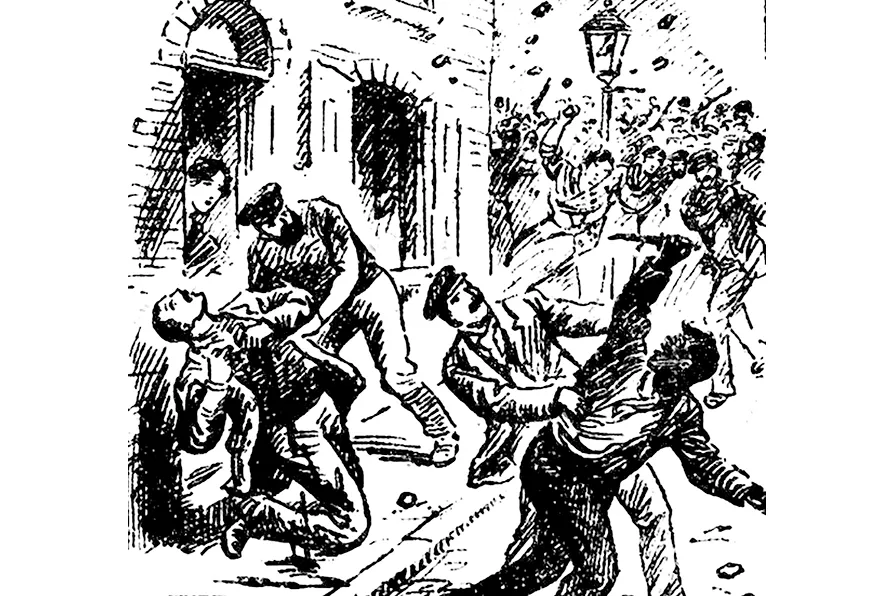From London’s holly-sellers to Engels’s flaming Christmas centrepiece, the plum pudding was more than festive fare in Victorian Britain, says KEITH FLETT
White racist rioting has many an infamous precedent in Britain, writes DAVID HORSLEY

 TENDENTIOUS: Illustration of the Cardiff riots from the Illustrated Police News, June 19 1919 - note the depiction of the black man as a knife-wielding assailant / Pic: Public domain
TENDENTIOUS: Illustration of the Cardiff riots from the Illustrated Police News, June 19 1919 - note the depiction of the black man as a knife-wielding assailant / Pic: Public domain
THIS year, we are witnessing racist attacks on migrants forced by successive government policy to make them live in hotels. The migrants scapegoated by fascist and far-right groups supported by constant negative reports in the mass media and worst of all by the current Labour government have led many people to participate in these events.
This situation has echoes of “race riots” throughout Britain in 1919.
During World War I, the Lloyd George government encouraged many throughout the empire to come to the “mother country” to help in the war effort, but once they were no longer needed politicians, sections of the media and labour movement misleaders were demanding repatriation.
Accused of taking “white men’s jobs” and exacerbated by racist newspaper stories such as a local Salford paper’s report “Niggers were strumming banjos while white girls danced,” the attacks began.
In Glasgow early that year, after “Red Clyde hero” and seafarers’ leader Manny Shinwell condemned “the hiring of Chinese and other coloured labour” and went on to link unemployment of white workers being due to Chinese and black seafarers, groups went on to rampage areas where those stigmatised lived in boarding houses.
In James Watt Street and Broomielaw Street mobs attacked those dwellings, forcing black seafarers to defend themselves. This resulted in one white man being arrested while 30 mainly from Sierra Leone were arrested.
South Shields had for decades been home to many Yemeni and Somali men working on merchant vessels. After false media rumours that “Arabs are being signed on every day to the disadvantage of Britishers,” there were attacks on Yemeni and other black people who were defending their houses, cafes and themselves. Labelled an “Arab riot” in the local press, 15 Yemenis were arrested with 12 being convicted, while none of the attackers were arrested.
London’s East End in the Cable Street area had for some time been home to black people, mainly seafarers, and after local press reports “objected to English girls visiting an Arab eating house,” violence broke out with those attacked having to defend themselves.
These events were reported as “ a growing evil in the cosmopolitan quarters of London.”
Liverpool had a long standing black population going back to Victorian times and in addition with many from the African continent and the Caribbean recruited for the war effort, the end of the war brought conflict over “white men’s jobs” being taken over.
From June 1919, there were vicious attacks on both black people and their houses. Charles Wootton, a 24-year-old sailor from Bermuda, was chased by a mob and forced into the water on the city’s docks and, despite the presence of police who appeared not to intervene, he was stoned to death with chants of “let him drown.”
In Cardiff, as in Liverpool, there was a longstanding black presence with black seafarers having married locals and settled there. As in Liverpool these workers usually had the worst jobs on board merchant ships with their union doing little to help them.
In the summer of 1919, after some black workers and their families were returning home in carriages after a day out, they were attacked by racist gangs. This violence spiralled with racist crowds going into Bute Town, where the majority of the black population lived, attacking homes and boarding houses and as elsewhere the people had to defend themselves.
Even the chief constable of Wales reported to the Home Office that the racism of white American sailors had “spread to soldiers and demobilised men.” Added to that were press reports of “a feeling of animosity against the coloured men because of their association with white girls.”
The pattern of racism throughout 1919 as we can see was provoked as now with false racist media reports, a racist government and racist organisations scapegoating then black people, now migrants.
One big positive difference in 2025 is a combination of trade unionists, local activists, anti-racists and organisations like Stand up to Racism.
We in the labour movement must mobilise against racism in trade unions, in our localities and communities and spread the word particularly with the Morning Star, the only daily newspaper that is truly anti-racist.

Once again Tower Hamlets is being targeted by anti-Islam campaigners, this time a revamped and radicalised version of Ukip — the far-right event is now banned by the police, but we’ll be assembling this Saturday to make sure they stay away, says JAYDEE SEAFORTH

A joint statement from Derby Indian Workers’ Association and Vox Feminarum/Women’s Voices

DAVID HORSLEY reminds us of the roots and staying power of one of the most iconic festivals around











